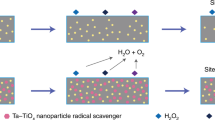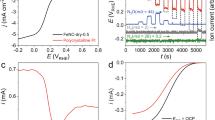Abstract
A material capable of rapid, reversible molecular oxygen uptake at room temperature is desirable for gas separation and sensing1,2, for technologies that require oxygen storage and oxygen splitting such as fuel cells (solid-oxide fuel cells in particular)3,4,5,6 and for catalytic applications that require reduced oxygen species (such as removal of organic pollutants in water and oil-spill remediation). To date, however, the lowest reported temperature for a reversible oxygen uptake material is in the range of 200–300 °C, achieved in the transition metal oxides SrCoOx (ref. 1) and LuFe2O4+x (ref. 2) via thermal cycling. Here, we report rapid and reversible oxygen scavenging by TiO2−x nanotubes at room temperature. The uptake and release of oxygen is accomplished by an electrochemical rather than a standard thermal approach1,2,7. We measure an oxygen uptake rate as high as 14 mmol O2 g−1 min−1, ∼2,400 times greater than commercial, irreversible oxygen scavengers. Such a fast oxygen uptake at a remarkably low temperature suggests a non-typical mechanistic pathway for the re-oxidation of TiO2−x. Modelling the diffusion of oxygen, we show that a likely pathway involves ‘exceptionally mobile’ interstitial oxygen8,9,10 produced by the oxygen adsorption and decomposition dynamics, recently observed on the surface of anatase6.
This is a preview of subscription content, access via your institution
Access options
Subscribe to this journal
Receive 12 print issues and online access
$259.00 per year
only $21.58 per issue
Buy this article
- Purchase on Springer Link
- Instant access to full article PDF
Prices may be subject to local taxes which are calculated during checkout





Similar content being viewed by others
References
Jeen, H. et al. Reversible redox reactions in an epitaxially stabilized SrCoOx oxygen sponge. Nature Mater. 12, 1057–1063 (2013).
Hervieu, M. et al. Oxygen storage capacity and structural flexibility of LuFe2O4+x (0 ≤ x ≤ 0.5). Nature Mater. 13, 74–80 (2014).
Shao, Z. & Haile, S. M. A high-performance cathode for the next generation of solid-oxide fuel cells. Nature 431, 170–173 (2004).
Arico, A. S., Bruce, P., Scrosati, B., Tarascon, J-M. & van Schalkwijk, W. Nanostructured materials for advanced energy conversion and storage devices. Nature Mater. 4, 366–377 (2005).
McEvoy, A. J. Materials for high-temperature oxygen reduction in solid oxide fuel cells. J. Mater. Sci. 36, 1087–1091 (2001).
Setvín, M. et al. Reaction of O2 with subsurface oxygen vacancies on TiO2 anatase (101). Science 341, 988–991 (2013).
Göpel, W., Rocker, G. & Feierabend, R. Intrinsic defects of TiO2(110): interaction with chemisorbed O2, H2, CO, and CO2 . Phys. Rev. B 28, 3427 (1983).
Hollister, A. G., Gorai, P. & Seebauer, E. G. Surface-based manipulation of point defects in rutile TiO2 . Appl. Phys. Lett. 102, 231601 (2013).
Gorai, P., Hollister, A. G. & Seebauer, E. G. Measurement of defect-mediated oxygen self-diffusion in metal oxides. ECS J. Solid State Sci. Technol. 1, Q21–Q24 (2012).
Seebauer, E. G. et al. Control of defect concentrations within a semiconductor through adsorption. Phys. Rev. Lett. 97, 055503 (2006).
Wahlström, E. et al. Electron transfer-induced dynamics of oxygen molecules on the TiO2(110) surface. Science 303, 511–513 (2004).
Schaub, R. et al. Oxygen-mediated diffusion of oxygen vacancies on the TiO2(110) surface. Science 299, 377–379 (2003).
Pacchioni, G. Oxygen vacancy: the invisible agent on oxide surfaces. ChemPhysChem 4, 1041–1047 (2003).
Gopal, C. B. & Haile, S. M. An electrical conductivity relaxation study of oxygen transport in samarium doped ceria. J. Mater. Chem. A 2, 2405–2417 (2014).
Richter, C. & Schmuttenmaer, C. A. Exciton-like trap states limit electron mobility in TiO2 nanotubes. Nature Nanotech. 5, 769–772 (2010).
Varghese, O. K., Paulose, M. & Grimes, C. A. Long vertically aligned titania nanotubes on transparent conducting oxide for highly efficient solar cells. Nature Nanotech. 4, 592–597 (2009).
Roy, P., Berger, S. & Schmuki, P. TiO2 nanotubes: synthesis and applications. Angew. Chem. Int. Ed. 50, 2904–2939 (2011).
Berger, S., Ghicov, A., Nah, Y. C. & Schmuki, P. Transparent TiO2 nanotube electrodes via thin layer anodization: fabrication and use in electrochromic devices. Langmuir 25, 4841–4844 (2009).
Diebold, U. The surface science of titanium dioxide. Surf. Sci. Rep. 48, 53–229 (2003).
Serpone, N. Is the band gap of pristine TiO2 narrowed by anion- and cation-doping of titanium dioxide in second-generation photocatalysts? J. Phys. Chem. B 110, 24287–24293 (2006).
Teng, F. et al. Preparation of black TiO2 by hydrogen plasma assisted chemical vapor deposition and its photocatalytic activity. Appl. Catal. B 148–149, 339–343 (2014).
Miltz, J. & Perry, M. Evaluation of the performance of iron-based oxygen scavengers, with comments on their optimal applications. Packag. Technol. Sci. 18, 21–27 (2005).
Tewari, G., Jayas, D. S., Jeremiah, L. E. & Holley, R. A. Absorption kinetics of oxygen scavengers. Int. J. Food Sci. Technol. 37, 209–217 (2002).
He, Y., Dulub, O., Cheng, H., Selloni, A. & Diebold, U. Evidence for the predominance of subsurface defects on reduced anatase TiO2 (101). Phys. Rev. Lett. 102, 106105 (2009).
Wendt, S. et al. The role of interstitial sites in the Ti3d defect state in the band gap of titania. Science 320, 1755–1759 (2008).
Iguchi, E. & Yajima, K. Diffusion of oxygen vacancies in reduced rutile (TiO2). J. Phys. Soc. Jpn 32, 1415–1421 (1972).
Roh, B. Defect Properties of Anodic Oxide Films on Titanium and Impact of Oxygen Vacancy on Oxygen Electrode Reactions PhD thesis, Pennsylvania State Univ. (2007).
Cheng, H. & Selloni, A. Energetics and diffusion of intrinsic surface and subsurface defects on anatase TiO2(101). J. Chem. Phys. 131, 054703 (2009).
Lu, H. F. et al. Amorphous TiO2 nanotube arrays for low-temperature oxygen sensors. Nanotechnology 19, 405504 (2008).
Acknowledgements
This work was supported by the Kate Gleason Fund.
Author information
Authors and Affiliations
Contributions
T.C., G.T., C.R. and C.D. conceived and designed the experiments. T.C. and G.T. performed the experiments. C.R., S.W. and T.C. analysed the data. C.D. contributed materials/measurement tools. All authors participated in writing the manuscript.
Corresponding author
Ethics declarations
Competing interests
The authors declare no competing financial interests.
Supplementary information
Supplementary information
Supplementary information (PDF 1674 kb)
Rights and permissions
About this article
Cite this article
Close, T., Tulsyan, G., Diaz, C. et al. Reversible oxygen scavenging at room temperature using electrochemically reduced titanium oxide nanotubes. Nature Nanotech 10, 418–422 (2015). https://doi.org/10.1038/nnano.2015.51
Received:
Accepted:
Published:
Issue Date:
DOI: https://doi.org/10.1038/nnano.2015.51
This article is cited by
-
Influence of electrochemical reduction on the optical properties of TiO2 nanotubes under ambient conditions
Applied Physics A (2021)
-
Proton-assisted creation of controllable volumetric oxygen vacancies in ultrathin CeO2−x for pseudocapacitive energy storage applications
Nature Communications (2019)
-
Transition metal oxide nanostructures: premeditated fabrication and applications in electronic and photonic devices
Journal of Materials Science (2018)
-
Electric-field control of tri-state phase transformation with a selective dual-ion switch
Nature (2017)
-
Toward new gas-analytical multisensor chips based on titanium oxide nanotube array
Scientific Reports (2017)



